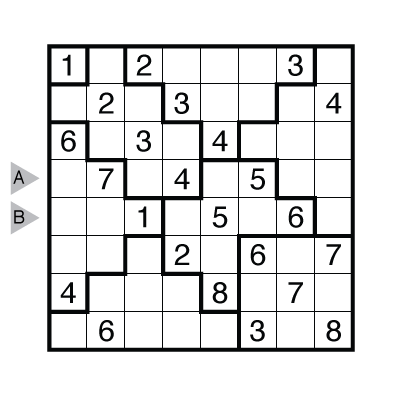Dr. Sudoku Prescribes #52 – Surplus Sudoku

or solve online (using our beta test of Penpa-Edit tools)
Theme: Double Diagonals
Rules: Standard Surplus Sudoku rules, with numbers from 1-8.
Answer String: Enter the 4th row from left to right, followed by a comma, followed by the 5th row from left to right.
Time Standards (highlight to view): Grandmaster = 1:45, Master = 2:45, Expert = 5:30
Solution: PDF

So my thoughts on this variant:
1. The constraints remove possible logical deductions rather than adding new possible deductions: You usually (though not always) have to avoid using the “one and only one of X in this region” deduction. This is not necessarily a bad thing since it forces the solver to concentrate on techniques which are used less often in normal Sudoku puzzles.
2. The constraints are asymmetrical – ie the rows/columns have a slightly different constraint than the regions whereas in most sudoku puzzles, the row/col/reg constraints are the same. This puts a heavier emphasis on looking for a missing/duplicated digit on the row/col than on the regions. Which is difficult for me since I usually find it easier look for duplicates/omissions in a region (less eye movement back and forth or up and down), and I usually restrict my scratch work to in-regions rather than along columns or rows (something I picked up from motris). It’s like an anti-motris-style genre.
I am slightly more of a positive inference solver so I am more affected by Deficit than Surplus. But both are good “training” genres as they shut off different aspects of standard solving.
If you prefer to always have your entire arsenal at hand, you won’t like Deficit or Surplus or other types like Blackout Sudoku, ….
>> If you prefer to always have your entire arsenal at hand, you won’t like Deficit or Surplus or other types like Blackout Sudoku, ….
It’s not really that I want my whole arsenal. What I like about variants is that they bring new ideas to the table by mixing old ideas together in new ways. This particular variant takes things off the table rather than adding something to it (at least on the surface). That’s not so much a complaint as an observation. Like I said, not necessarily bad, just not necessarily good.
I’m definitely of the school who is bothered more by deficit than by surplus. One of my natural starting points is “where must the N be in this region?”, and the only thing different about that in surplus is if you have more than one possible slot, and they aren’t in the same row/column, then there could be more than one of them filled. On the other hand, “there’s only one place the N could be! If it even exists. Which it doesn’t really have to…” in Deficit makes me feel all paranoid and edgy.
This isn’t, strictly speaking, just a Surplus is it? That little group with a single one in it seems to make it a Deficit/Surplus combo. Just curious.
The single cell really isn’t a region at all as it has no rule to it. It’s just one digit, which means the deficit rule of no repeats doesn’t come into play for it at all. So therefore it’s really just a surplus sudoku as all regions that have interaction between digits are surplus cages.
The original deficit formulation was (n+1) regions of size (n-1) which leaves a single cell. The original surplus formulation was (n-1) regions of size (n+1) which also leaves a single cell. That singleton gets to be ignored in most cases as just a cell and not a region.
You’ll see a true Deficit/Surplus combo later.
(Spoiler warning – or hint warning, anyway)
This is the first time I’ve seen this puzzle type. My immediate deduction was that with seven regions, and eight instances of each number in the puzzle, each region must have a different number as the duplicate number. So I set about trying to figure out which number was duplicated in each region before doing anything else.
1 may not be duplicated anywhere, since it already appears in the single cell. Some regions already had duplicate numbers. If so, I circled one of them to make it more obvious.
I then figured out which number was duplicated in each of the other regions by elimination. Only one region could hold two 4s, for example.
Once I had identified the set of numbers that had to be placed in each region, the rest of the solve was straightforward.
This is not a particularly nasty puzzle, but your first inclination — to “bookkeep” where the extra digits go — is the new thing the type sometimes brings. Glad to hear that is what you tried first!
The same idea is true of Deficit Sudoku, but you keep track of which numbers are missing and across the whole puzzle there is a whole set of 1-N missing, and the number in the small cell is missing twice.
5:45
Went wrong .Realised that after 45-50 seconds and started solving again.
Nice puzzle type and a nice puzzle!!